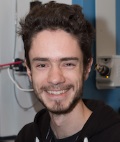Table of Contents |
guest 2024-04-20 |
Event Information
Speakers
Michael MacCoss
Josh Eckels
Jay Kirkwood
Brendan MacLean
Matthew MacDonald
Diana A.T. Nijholt
Bing Peng
Chris Petzold
Lindsay Pino
Thierry Schmidlin
Qi Tang
Thanks!
The fifth annual Skyline User Group Meeting was held in the 107-year old Gunter Hotel -- one of the most historic and continuously operating grand hotels in San Antonio, TX. The meeting was held the Sunday, June 5, before the 2016 ASMS conference and the room was packed with 200 attendees hearing about the latest targeted proteomic and "omics" research approaches -- using Skyline. After a brief introduction by host Dr. Mike MacCoss, the event featured 10 speakers on a wide spectrum of ways that researchers were using Skyline to tackle innovative mass spectrometry projects. This year, the User Group Meeting also solicited audience topics from the user base -- and selected from culling through submitted abstracts. In addition to full length (20 min.) presentations, this years meeting also featured rapid-fire "lightning talks" -- in which speakers had the unenviable task of culling down their current key research into a mere 4 minute talk with 1 minute for Q&A. Despite the wildly truncated format, the lightening talks were as informative as they were amusingly fast-paced -- be sure to check them out in the recordings below. We've also posted the presentation slides in the links below for your continued reference.
Lastly, we'd like to give a heart-felt "thank you" to all of our speakers who prepared and gave up their pre-ASMS Sunday make the Skyline User Group Meeting an event not to be missed. And to those who attended this year, we hope to see you all at a future Skyline User Group Meeting!
Michael J. MacCoss, Ph.D. (University of Washington):
Introduction and event host
Josh Eckels (LabKey):
Improved Quality Control Workflows and Other Panorama Updates
Jay Kirkwood, Ph.D. (Colorado State University):
The Flux Capacitor: Using Skyline for efficient processing of LC-MS/MS metabolic flux data
Brendan MacLean, (MacCoss Lab, University of Washington):
Status of the Skyline open-source software project 8 years after its inception
Diana A.T. Nijholt, Ph.D. (Erasmus MC):
Validating PZP as a biomarker for presymptomatic Alzheimer’s disease using targeted proteomics approaches
Lindsay Pino, (University of Washington):
Applying lessons learned from targeted mass spectrometry to data-independent acquisition (DIA) assays
Thierry Schmidlin, (Utrecht University):
Extending Selected Reaction Monitoring to Monitor Diet-Induced Neuropeptide Signaling
Lightning Talks
Matthew MacDonald, Ph.D. (University of Pittsburgh):
Synaptic Protein Networks in Neuropsychiatric Disease
Bing Peng, (ISAS):
Adaptation of Skyline for Targeted Lipidomics
Chris Petzold, Ph.D. (Lawrence Berkeley National Lab):
A Skyline-based workflow for rapid development of high-throughput quantitative proteomic assays
Qi Tang, (ProteinT Biotech):
Edited transition and RT information in Skyline library improves DIA quantification of cerebral spinal fluid (CSF) proteomes
Event Information
Welcome
The Skyline Team is pleased to announce the Fifth Annual Skyline User Group Meeting, which will be held in San Antonio, TX on Sunday afternoon before ASMS. We would like to thank the event sponsors (see below) for their generosity and interest in collaborating with the Skyline project on exciting new targeted and quantitative proteomics techniques.
--Brendan
When: Sunday, June 5, 2016
12:00 - 1:00 pm : Lunch served
1:00 - 2:30 pm : Presentations
2:30 - 3:00 pm : Snacks and break-out discussions
3:00 - 4:30 pm : Presentations
Where: Sheraton Gunter Hotel (http://www.sheratongunter.com), 205 East Houston Street, San Antonio, TX, 78205 (map)
- The Sheraton Gunter is located about 15-20 walk northwest of the Henry B. Gonzalez Convention Center.
- From the Convention Center northwest exit, take a right on South Alamo, left on E. Commerce, right on Navarro and a left on Houston. Sheraton Gunter is about a block more on the right side of the street.
- Skyline User Group Meeting will be in the Crystal-Yellowrose rooms, on the first floor of the historic hotel.
[registration closed]
Confirmed Speakers
Michael J. MacCoss, Ph.D. (University of Washington): Introduction and event host
Josh Eckels (LabKey):Improved Quality Control Workflows and Other Panorama Updates
Panorama is a web-based complement to Skyline, used by more than a hundred organizations to manage, analyze, and share targeted mass spec data generated by Skyline. Since being unveiled at ASMS 2015, Panorama’s support for QC workflows has expanded significantly. (More info...)
Jay Kirkwood, Ph.D. (Colorado State University): The Flux Capacitor: Using Skyline for efficient processing of LC-MS/MS metabolic flux data
With the recent understanding that metabolic flux is often fundamentally altered with common disease states, there is now great interest in developing LC-MS based methods for the analysis of metabolic flux in living systems. Dependent on molecular formula, the fragment ion, and the isotopically labeled precursor, multiple SRM transitions are required to monitor for all the potential labeling patterns for a given metabolite (i.e. 36 transitions for argininosuccinate in our method). (More info...)
Brendan MacLean, (MacCoss Lab, University of Washington): Status of the Skyline open-source software project 8 years after its inception
The Skyline project started just after ASMS 2008 as a 2-year effort to bring better SRM/MRM software tools to the NCI-CPTAC Verification Working Group that could support the variety of mass spectrometers in use in participating laboratories. Nearly 8 years later, the Skyline project is a thriving proteomics community open-source collaboration supporting 6 mass spec instrument vendors integrated with a wide variety of external software, with thousands of users worldwide and many thousands of instances started each week. (More info...)
Diana A.T. Nijholt, Ph.D. (Erasmus MC): Validating PZP as a biomarker for presymptomatic Alzheimer’s disease using targeted proteomics approaches
Our group previously identified PZP as a potential serum biomarker for presymptomatic Alzheimer’s disease. A targeted MS method (SRM) including stable isotope labelled peptides was set up in our laboratory for absolute quantification of PZP. Measurements were performed on a Xevo TQ-S triple quadrupole (Waters) mass spectrometer. We make use of Skyline for method optimization (transition selection, collision energy) and data analysis of the PZP SRM method. (More info...)
Lindsay Pino, (University of Washington): Applying lessons learned from targeted mass spectrometry to data-independent acquisition (DIA) assays
Advantages of a data independent acquisition (DIA)-MS workflow include comprehensive, unbiased, and reproducible sampling of ions, which coupled to peptide-centric analysis provides mass spectrometrists with data sets that make subsequent comparison quantification of target analytes much easier. (More info...)
Thierry Schmidlin, (Utrecht University): Extending Selected Reaction Monitoring to Monitor Diet-Induced Neuropeptide Signaling
The analysis of neuropeptides has moved into focus in recent years, as their regulation is key in understanding a variety of functional processes, such as energy balance, drug addiction, etc. The biosynthesis of neuropeptides involves multiple trimming steps and post translational modification, thus impeding the prediction of the active peptide from the genome sequence or even the precursor protein. (More info...)
Lightning Talks
Matthew MacDonald, Ph.D. (University of Pittsburgh): Synaptic Protein Networks in Neuropsychiatric Disease
Synaptic architecture and its adaptive remodeling require complex molecular events involving thousands of proteins. Many neuropsychiatric illnesses are complex trait disorders in which multiple genetic risk factors converge on neuronal protein networks, altering synaptic architecture and impairing brain function. A quantitative window into the synaptic proteome of brain tissue from patients is essential to understanding this neuropsychiatric disease pathogenesis. (More info...)
Bing Peng, (ISAS): Adaptation of Skyline for Targeted Lipidomics
In response to the urgent-need for analysis software that is capable of handling data from targeted high-throughput lipidomics experiments, we here present a systematic workflow for the straightforward method design and analysis of selected reaction monitoring data in lipidomics based on lipid building blocks. Skyline is a powerful software primarily designed for proteomics applications where it is widely-used. (More info...)
Chris Petzold, Ph.D. (Lawrence Berkeley National Lab): A Skyline-based workflow for rapid development of high-throughput quantitative proteomic assays
Quantitative proteomic assays are a key component of a wide variety of studies in biotechnology research, especially for synthetic biology and metabolic engineering applications that often involve sample sets in the hundreds or thousands. Complicating the analysis further is the fact that the target proteins and organisms of interest are often different across experiments. (More info...)
Qi Tang, (ProteinT Biotech): Edited transition and RT information in Skyline library improves DIA quantification of cerebral spinal fluid (CSF) proteomes
DIA-based proteomic profiling is an essential tool for molecular data collection in precision medicine. Skyline is one of very few available programs for deciphering DIA data. We performed proteomic comparison of CSF between 15 brain medullablastomas and 15 metastasis cases to seek for distinguishing biomarkers.( More info...)
Sponsors
 |
 |
 |
 |
 |
 |
 |
 |
Speakers
Ten speakers with interesting and different areas of expertise in Skyline use and development are scheduled to speak at the Skyline User Group Meeting at ASMS 2016 in San Antonio, TX.
Michael MacCoss
 |
Michael MacCoss Mike became interested in biomedical applications of mass spectrometry while working in Dr. Patrick Griffin’s protein mass spectrometry lab at Merck Research Laboratories. He obtained a Ph.D. with Professor Dwight Matthews and pursued a postdoc with Professor John R. Yates III. In 2004 he started the MacCoss lab at the University of Washington and it became obvious that while mass spectrometry data could be collected quickly and robustly, the lack of computational tools for the visualization and analysis of these data was a stumbling block. In 2008 he hired Brendan MacLean with the goal of developing professional quality software tools for quantitative proteomics.
Read More
Mike has worked closely with the Skyline development team and our outstanding group of laboratory scientists and collaborators to ensure that our software uses analytical approaches that have been thoroughly vetted by the mass spectrometry community.
|
Josh Eckels
 |
Josh Eckels has lead development on proteomics related projects for LabKey Server over the past 10+ years, and he currently oversees Panorama development. He is experienced in security-related projects, client-side end user applications, and server-side development. Prior to joining LabKey, Josh worked most recently on Amazon.com's data warehouse, developing the software that schedules and executes loading and querying of more than 30 terabytes of data. Before that, he was the team lead for the debugger for BEA System's WebLogic Workshop. At LabKey, he focuses on mass spectrometry, other assay types, experimental annotations and general infrastructure. Josh has a BS in Computer Engineering from Northwestern University.
Improved Quality Control Workflows and Other Panorama UpdatesPanorama is a web-based complement to Skyline, used by more than a hundred organizations to manage, analyze, and share targeted mass spec data generated by Skyline. Read More
Since being unveiled at ASMS 2015, Panorama’s support for QC workflows has expanded significantly. With input from the SProCoP team and the user community, new and improved metrics, automation, and visualizations build on the previous functionality. Additionally, Skyline and Panorama now include document version tracking for method building and other workflows, and Panorama now supports small molecule data. This presentation will demonstrate the new capabilities and outline plans for Panorama’s ongoing development.
[PDF] |
Jay Kirkwood
 |
Jay Kirkwod, Ph.D., received his PhD in Medicinal Chemistry from Oregon State University in 2013. The focus of his thesis was the development and broad biological application of both targeted and untargeted LC-MS based metabolomics platforms. He is currently a post-doctoral scientist at Colorado State University where his research is focused on the development and implementation of targeted, quantitative small molecule assays using triple quadrupole mass spectrometry. A highlight of Jay's current research is the development of a HILIC based LC-MS based method for the quantitative, kinetic flux profiling of various polar small molecules belonging to a diverse set of metabolic pathways.
The Flux Capacitor: Using Skyline for efficient processing of LC-MS/MS metabolic flux dataWith the recent understanding that metabolic flux is often fundamentally altered with common disease states, there is now great interest in developing LC-MS based methods for the analysis of metabolic flux in living systems. Read More
Dependent on molecular formula, the fragment ion, and the isotopically labeled precursor, multiple SRM transitions are required to monitor for all the potential labeling patterns for a given metabolite (i.e. 36 transitions for argininosuccinate in our method). As SRM number increases in the MS method, so does the burden associated with data processing. The open source software Skyline-daily was used to efficiently process metabolic flux profiling data for several hundred transitions corresponding to ~ 40 metabolites from various metabolic pathways. Method application is illustrated by kinetic flux profiling of liver cells infected with the Dengue virus, using U-13C-glucose as the labeled precursor.
[PDF] |
Brendan MacLean
 Brendan MacLean worked at Microsoft for 8 years in the 1990s where he was a lead developer and development manager for the Visual C++/Developer Studio Project. Since leaving Microsoft, Brendan has been the Vice President of Engineering for Westside Corporation, Director of Engineering for BEA Systems, Inc., Sr. Software Engineer at the Fred Hutchinson Cancer Research Center, and a founding partner of LabKey Software. In this last position he was one of the key programmers responsible for the Computational Proteomics Analysis System (CPAS), made significant contributions to the development of X!Tandem and the Trans Proteomic Pipeline, and created the LabKey Enterprise Pipeline. Read More
Brendan MacLean worked at Microsoft for 8 years in the 1990s where he was a lead developer and development manager for the Visual C++/Developer Studio Project. Since leaving Microsoft, Brendan has been the Vice President of Engineering for Westside Corporation, Director of Engineering for BEA Systems, Inc., Sr. Software Engineer at the Fred Hutchinson Cancer Research Center, and a founding partner of LabKey Software. In this last position he was one of the key programmers responsible for the Computational Proteomics Analysis System (CPAS), made significant contributions to the development of X!Tandem and the Trans Proteomic Pipeline, and created the LabKey Enterprise Pipeline. Read More
Status of the Skyline open-source software project 8 years after its inception
The Skyline project started just after ASMS 2008 as a 2-year effort to bring better SRM/MRM software tools to the NCI-CPTAC Verification Working Group that could support the variety of mass spectrometers in use in participating laboratories. Nearly 8 years later, the Skyline project is a thriving proteomics community open-source collaboration supporting 6 mass spec instrument vendors, integrated with a wide variety of external software, with thousands of users worldwide and many thousands of instances started each week. In this presentation, the Skyline principal developer will present recent developments and a roadmap for the project's future. Topics covered will include:- Advances in DIA workflow support
- Growing support for targeting small molecules in Skyline
- Calibrated (a.k.a. Absolute) quantification with Skyline
- Growth in the Skyline software ecosystem for targeted MS (Skyline, Panorama, Chorus and External Tools)
- Strong industry support from instrument vendors
- Courses, workshops, webinars and other efforts to create instructional resources for the Skyline community
[PDF]
Matthew MacDonald
Matthew MacDonald, Ph.D., throughout his graduate and postdoctoral training to his current position as an Assistant Professor of Psychiatry, University of Pittsburgh, Matthew's main focus of research has been validating and utilizing targeted proteomics approaches to investigate synaptic protein network dysfunction in postmortem brain tissue from patients with neuropsychiatric disease. As a graduate student at the University of Pennsylvania, Matthew worked with Drs. Chang-Gyu Hahn and Ian Blair to validate a biochemical fractionation – targeted proteomics approach for protein quantification in synaptic microdomain enrichments from human postmortem brain tissue of schizophrenia subjects. As a postdoctoral fellow with Drs. Robert Sweet and Nathan Yates, University of Pittsburgh, he eveloped a laser capture microdissection - targeted proteomics approach for multiplexed protein quantification in discreet cortical layers from human brain tissue.
Synaptic Protein Networks in Neuropsychiatric DiseaseSynaptic architecture and its adaptive remodeling require complex molecular events involving thousands of proteins. Read MoreMany neuropsychiatric illnesses are complex trait disorders in which multiple genetic risk factors converge on neuronal protein networks, altering synaptic architecture and impairing brain function. A quantitative window into the synaptic proteome of brain tissue from patients is essential to understanding this neuropsychiatric disease pathogenesis. Utilizing targeted proteomics, paired with biochemical fraction or laser capture microdissection, we investigated synaptic protein expression in postmortem brain tissue from patients with schizophrenia and Alzheimer’s disease. To enhance the value of these data sets generated with skyline, we utilized weighted co-expression networking analyses to identify links between risk alleles, synaptic protein network features, and known synaptic architecture alterations in these diseases. For example, we recently identified a module of co-expressed proteins, observed only in schizophrenia, whose expression is strongly linked to cortical spine loss, a well-documented synaptic architectural abnormality.
[PDF] |
Diana A.T. Nijholt
 |
Diana A.T. Nijholt, Ph.D. received her doctorate degree in neuroscience at the university of Amsterdam in 2012 and joined the research group of Dr. Luider, department Neurology, ErasmusMC, Rotterdam in the same year. Here, she continued her studies on neurodegeneration, particularly Alzheimer’s disease, with a renewed focus on the discovery and validation of biomarkers for the early presymptomatic stage. She has gained expertise in the field of targeted mass spectrometry, including SRM and PRM assays.
Validating PZP as a biomarker for presymptomatic Alzheimer’s disease using targeted proteomics approachesOur group previously identified PZP as a potential serum biomarker for presymptomatic Alzheimer’s disease. A targeted MS method (SRM) including stable isotope labelled peptides was set up in our laboratory for absolute quantification of PZP. Measurements were performed on a Xevo TQ-S triple quadrupole (Waters) mass spectrometer. We make use of Skyline for method optimization (transition selection, collision energy) and data analysis of the PZP SRM method. Read More We are currently quantifying PZP in a larger sample set (n=300) to validate its use as a biomarker, using Skyline as an analysis tool. These data will be presented during the user meeting. In addition, several other biomarker candidates (e.g. ApoE, CR1) will be analysed in SRM and PRM mode. This work is performed as part of the Dutch Biomarker Development Center,
(www.biomarkerdevelopmentcenter.nl) aimed at validating potential biomarkers for use in the clinic.
[PDF] |
Bing Peng
 |
Bing Peng, M.Sc. is a research associate at lipidomics group at Leibniz-Institut für Analytische Wissenschaften (ISAS) in Dortmund, and a Ph.D. student in the institute of applied analytical chemistry at University of Duisburg-Essen, Germany. She completed her B.Sc. and M.Sc. in Chemistry at China Agricultural University, Beijing. Her research focuses on developing mass spectrometry based techniques to identify lipid biomarkers in severe bleeding diseases. In 2014 she began to use Skyline attracted by its streamlined data analysis features. As a non-informatician, she successfully adapted Skyline for targeted lipidomics analysis in her proof of concept study.
Adaptation of Skyline for Targeted LipidomicsIn response to the urgent-need for analysis software that is capable of handling data from targeted high-throughput lipidomics experiments, we here present a systematic workflow for the straightforward method design and analysis of selected reaction monitoring data in lipidomics based on lipid building blocks. Read MoreSkyline is a powerful software primarily designed for proteomics applications where it is widely-used. We adapted this tool to a ‘Plug and Play’ system for lipid research. This extension offers the unique capability to assemble targeted mass spectrometry methods for complex lipids easily by making use of building blocks. With simple yet tailored modifications, targeted methods to analyze main lipid classes such as glycerophospholipids, sphingolipids, glycerolipids, cholesteryl-esters and cholesterol can be quickly introduced into Skyline for easy application by end users without distinct bioinformatics skills. To illustrate the benefits of our novel strategy, we used Skyline to quantify sphingolipids in mesenchymal stem cells.
[PDF] |
Chris Petzold
 |
Chris Petzold, Ph.D., is is a research scientist with Lawrence Berkeley National Laboratory and Director of Proteomics of the Joint BioEnergy Institute. He obtained his Ph.D. in Chemistry from Purdue University with emphasis in gas-phase ion chemistry and mass spectrometric methods development. After graduating from Purdue, he performed his post-doctoral work at UC-Berkeley focusing on mass spectrometry-based glycomics and lipidomics research. At the Joint BioEnergy Institute the proteomics team develops quantitative methods to aid synthetic biology efforts to engineer microbes for biofuel production. This work furthers rational design and optimization of novel metabolic pathways for many synthetic biology applications.
A Skyline-based workflow for rapid development of high-throughput quantitative proteomic assaysQuantitative proteomic assays are a key component of a wide variety of studies in biotechnology research, especially for synthetic biology and metabolic engineering applications that often involve sample sets in the hundreds or thousands. Read MoreComplicating the analysis further is the fact that the target proteins and organisms of interest are often different across experiments. Consequently, we have developed a Skyline-based workflow utilizing spectral libraries generated from shotgun proteomics experiments, iRT-based retention time prediction, and highly reproducible standard flow chromatography that enables the use of narrow retention time windows to minimize concurrent transitions and optimize sensitivity. With this workflow we can directly and reliably translate peptide identification data from 120-minute gradient shotgun proteomic runs to scheduled MRM experiments with 2-minute gradients. We have applied the workflow to quantify proteins in >10 different microbes, including targeting >50 proteins from more than 3000 samples (>500 strains, 2 conditions, 3 replicates) of Escherichia coli.
[PDF] |
Lindsay Pino
 |
Lindsay K. Pino is a Ph.D. candidate at the University of Washington’s Department of Genome Sciences in the MacCoss lab. Her research interests include the development of large-scale proteomics assays using data independent acquisition-MS to investigate complex mixtures and applying computational techniques to mine the resulting high-dimensional data. Prior to joining the MacCoss lab, she worked as a research associate at the Broad Institute of MIT and Harvard in Dr. Steve Carr’s Proteomics Platform, where she worked under Dr. Susan Abbatiello to improve the speed and selectivity of targeted proteomics assays using high-field asymmetric waveform ion mobility spectrometry (FAIMS).
Applying lessons learned from targeted mass spectrometry to data-independent acquisition (DIA) assaysAdvantages of a data independent acquisition (DIA)-MS workflow include comprehensive, unbiased, and reproducible sampling of ions, which coupled to peptide-centric analysis provides mass spectrometrists with data sets that make subsequent comparison quantification of target analytes much easier. Read More However, challenges in making confident, reproducible quantifications on such a large scale remain. In this presentation, I will present the adaption of strategies we have found important in fully targeted assay development (i.e SRM and PRM) towards the quantification of peptides from DIA experiments.
[PDF] |
Thierry Schmidlin
 |
Thierry Schmidlin,M.Sc. studied Biology at ETH Zurich (Switzerland) obtaining a M.Sc. in 2013. During his master thesis under supervision of Prof. Ruedi Aebersold, he started to learn Selected Reaction Monitoring focusing on phosphorylation events linked to autophagy in yeast. Since 2013, Thierry has been working as a Ph.D. student at Utrecht University (The Netherlands) under the joint supervision of Dr. Maarten Altelaar and Prof. Albert Heck. The main focus of his research is method development in SRM, MRM3 and DIA to study disease related signaling by or protein phosphorylation or endogenous peptides
Extending Selected Reaction Monitoring to Monitor Diet-Induced Neuropeptide SignalingThe analysis of neuropeptides has moved into focus in recent years, as their regulation is key in understanding a variety of functional processes, such as energy balance, drug addiction, etc. Read MoreThe biosynthesis of neuropeptides involves multiple trimming steps and post translational modification, thus impeding the prediction of the active peptide from the genome sequence or even the precursor protein. Therefore we believe that the analysis of undigested neuropeptides by a reproducible and robust method such as SRM is vital to accurately quantify the biologically active compounds. In a proof of principle study we quantified 15 neuropeptides in a rat obesity model using Skyline to perform assay development and optimization. We could show, that despite common practice precursor and fragment charges of up to 5 and 3 respectively do not limit the quality of the SRM peak groups, however require a dedicated individual optimization of the collision energies.
[PDF] |
Qi Tang
 |
Qi Tang, B.S., earned his Bachelor of Science degree from Hunan Normal University in China. He has been trained and specialized in mass spectrometry and computer programming. Qi was Proteomic Program Director at BGI, the world-leading institution in genomic sequencing and molecular profiling. In 2014, Qi became Sr. R&D Director at his current employer, ProteinT Biotech in Tianjin, China. Qi’s research interests mainly include creating DIA-based proteomic database for a variety of diseases, developing MS-based diagnostic panels, and several other proteomic-based clinical assays.
Edited transition and RT information in Skyline library improves DIA quantification of cerebral spinal fluid (CSF) proteomesDIA-based proteomic profiling is an essential tool for molecular data collection in precision medicine. Skyline is one of very few available programs for deciphering DIA data. Read MoreWe performed proteomic comparison of CSF between 15 brain medullablastomas and 15 metastasis cases to seek for distinguishing biomarkers. Our novel steps include: (1) using reference peptides for RT normalization in every DDA and DIA runs; (2) enriching transition list in DDA: we pooled every 5 samples and performed LC-fractionization prior to MS, and combined transition list into .blib files; (3) improving RT accuracy: with iRT strategy, we correlated RTs of a certain peptide in every DDAs with each DIA and assigned the most precise (median) RT to the peptide in a new RT profile; (4) by combing files from (2) and (3), we generated “personalized” and optimized Skyline library for each DIA. We developed valuable diagnostic panels for medullablastoma metastasis.
[PDF] |